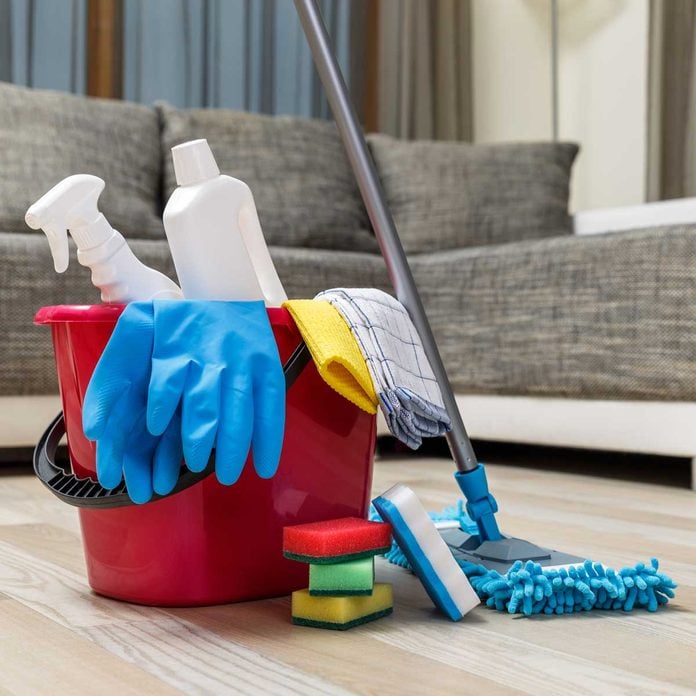CDC Approved: Cleaning Products That Actually Disinfect
Updated: Dec. 08, 2023

Ever wonder what you can use to not just clean, but actually disinfect your home's surfaces? We have the answers.
Clean is one thing. Disinfected is something more. While a quick glance usually is good enough to assess whether something is clean, it’s harder to tell if your counters, clothes or anything else have been properly disinfected.
Disinfecting is especially important when dealing with viruses, which may remain viable for hours or days on some surfaces, according to the Centers for Disease Control and Prevention. The CDC recommends cleaning visibly dirty surfaces, then disinfecting to kill germs and viruses. That’s vital to prevent the spread of viral respiratory and other illnesses in households and community settings.
But what are the right products and methods for disinfecting? Read on to find out what the CDC and other expert sources say.
On This Page
Which Household Products Can Disinfect?
Your best options are bleach and alcohol.
Bleach
The CDC recommends using diluted household liquid chlorine bleach, as long as the solution is safe for the surface. Make sure the bleach is not past its expiration date.
To make a large batch of disinfectant with bleach, mix five tablespoons (1/3 cup) bleach per gallon of water. That can be used on floors, or split up and stored in spray bottles for use in other areas throughout the home. For smaller batches, mix four teaspoons bleach per quart of water.
Let the mixture sit for 10 minutes, then wipe the area down with a clean paper towel or cloth. Clean is key, so you don’t move germs around.
As always when using bleach, work in a well-ventilated area.
Alcohol
With alcohol, you have two choices: ethanol (also known as ethyl alcohol) and isopropyl. Ethanol goes into alcoholic beverages, while isopropyl is the ingredient in rubbing alcohol. The two alcohols differ in their chemical structures, but essentially perform the same function in disinfecting.
The CDC recommends using at least 70 percent alcohol for killing viruses. You can use it full strength.
While you may be tempted to disinfect with vodka, don’t. Liquor is rarely over 60 percent alcohol, thus ineffective against germs and viruses. Find out if you can disinfect your bed by spraying alcohol.
Commercial Household Cleaners and Disinfectants
The U.S. Environmental Protection Agency (EPA) requires any product labeled as a disinfectant to list on its label the active ingredients that kill germs and which germs they kill. The active ingredient in many household cleaning products is bleach or alcohol.
When using household cleaners and disinfectants, be sure to follow label directions. For some products to kill viruses, the surface may need to remain wet for several minutes.
The EPA keeps a list of disinfectants, including popular cleaners such as Clorox Multi Surface Cleaner + Bleach and Lysol Disinfecting Wipes. Because many disinfectants are sold under different brand names, check the EPA registration number on the label and compare it to the list to be sure.
Disinfection Cleaning Tips
Whichever disinfecting product you use, clean with soap and water first to remove any excess dirt or grime. And use disposable rubber gloves or a pair dedicated to this purpose alone. The American Cleaning Institute recommends you let the surface dry after disinfection, and rinse toys or food-contact surfaces such as countertops with water after.
Products for Disinfecting Soft Surfaces
With soft surfaces such as rugs, carpeting and furniture, the CDC suggests cleaning with soap and water, or cleaners designed for those surfaces. Then finish with an EPA-registered household disinfectant such as Lysol Disinfectant Spray.
When doing laundry, be sure to wear disposable gloves, then wash your hands with soap and water immediately after removing the gloves. Wash items according to the manufacturer’s directions, using the warmest appropriate water setting. Then dry all items thoroughly.
Wash towels often, every two days if possible. Charles Gerba, a professor of environmental science at the University of Arizona, told Time magazine that germs can survive regular detergent. Gerba says for towels, use hot water and a product with activated oxygen bleach.
Don’t forget to clean and disinfect clothing hampers and baskets.
Products for Disinfecting Electronics
To clean electronic devices such as keyboards, remotes, touch screens and tablets, the CDC recommends following the manufacturer’s instructions. “If no guidance, use alcohol-based wipes or sprays containing at least 70 percent alcohol. Dry surface thoroughly,” the CDC says.
